Keivan G. Stassun
Stevenson Professor
Physics & Astronomy
Vanderbilt University
Research
UVEX: The Ultraviolet Explorer
Exploring the Dynamic Ultraviolet Universe
Launching in 2030!

UVEX Science Pillars
UVEX will address outstanding questions in our understanding of the Universe, including the nature of the low-mass, low-metallicity galaxy population and the early ultraviolet emission of explosive transients. UVEX will also leave a rich legacy of all-sky ultraviolet data.
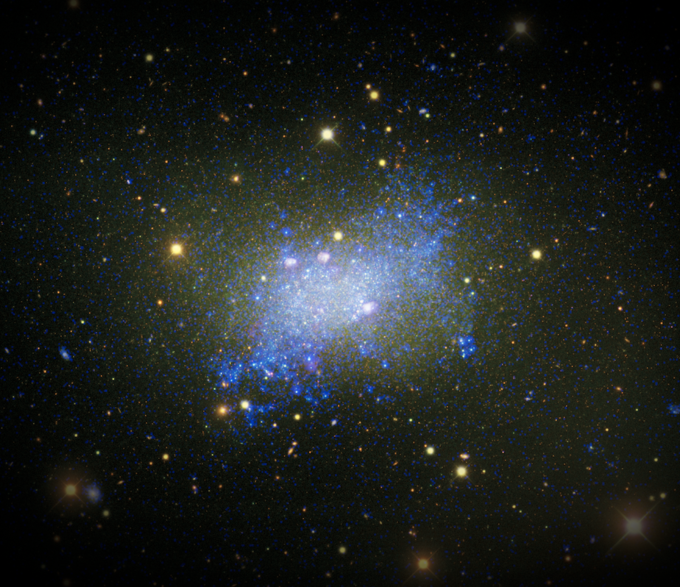 |
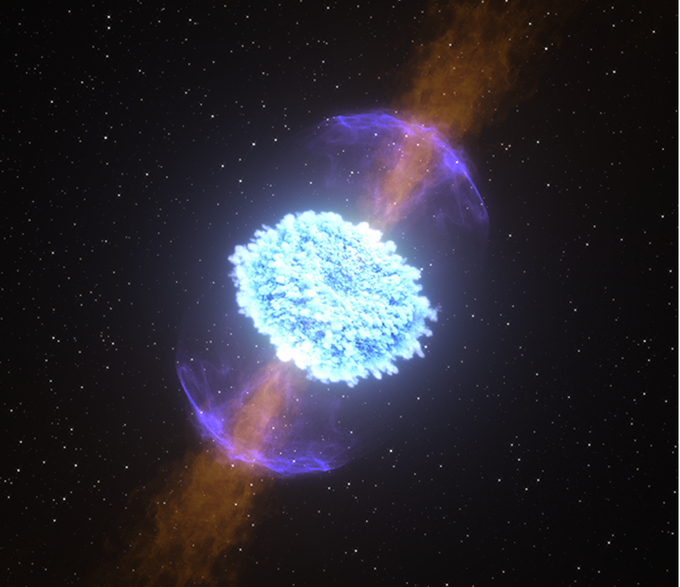 |
 |
| The Low-Mass, Low-Metallicity Galaxy Frontier | New Views of the Dynamic Universe | A Legacy of Deep, Synoptic All-Sky Data |
| UVEX will identify low-mass, low-metallicity galaxies in the nearby Universe, diagnose the nebular emission of analogs to high-redshift galaxies, and study hot stars in the Large and Small Magellanic Clouds, our neighboring low-metallicity laboratories. | UVEX will probe the short-lived UV emission from merging neutron stars, perform spectral follow-up of the first hours of core collapse supernovae, and provide a community resource for target-of-opportunity observations. | By performing a cadenced all-sky survey 50–100x more sensitive than GALEX, UVEX will generate a wealth of photometric and spectroscopic data, opening vast discovery space for the future, with depth and resolution matching modern optical and infrared surveys. Led by the Stassun Lab at Vanderbilt. |
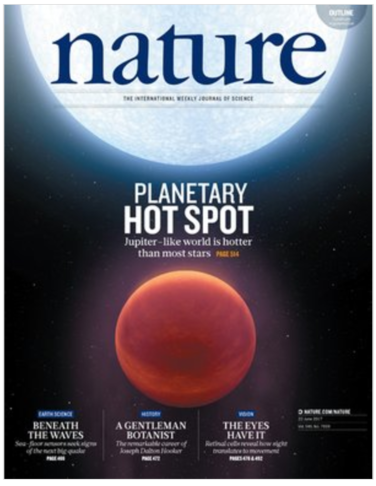 Astronomers discover an exoplanet hotter than most stars.
Astronomers discover an exoplanet hotter than most stars.
An international team of astronomers have discovered a planet like Jupiter zipping around its host star every day, boiling at temperatures hotter than most stars and sporting a giant, glowing gas tail like a comet. The discovery was made with Vanderbilt's KELT telescope and is published in the journal Nature. See the Vanderbilt News press release for more details.

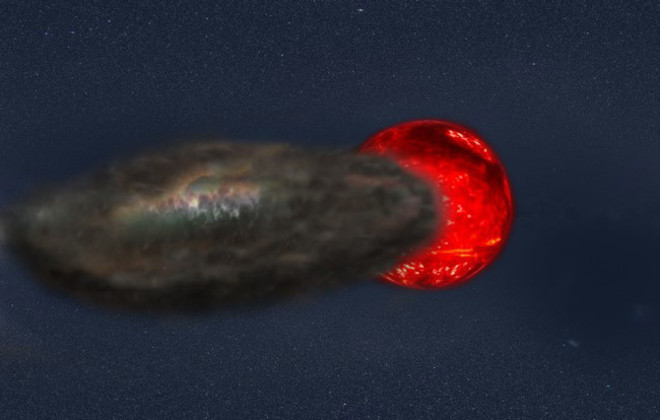
IT'S OFFICIAL: WORLD RECORD SETTING STELLAR ECLIPSE
The longest stellar eclipse lasts around 3.45 years and takes place in a binary star system called TYC 2505-672-1. The discovery was made by the Stassun Research Group, and published on 19 January 2016. The eclipse takes place once every 69 years. From the viewpoint of an observer on Earth, the red giant component of the binary system is eclipsed by its companion star. The companion star - which the research team think could be a 'stripped red giant', which is on its way to becoming a white dwarf - is surrounded by a huge disc of opaque dust which blocks out almost all of the light from the red giant.
THIS IS WHAT HAPPENS WHEN STARS EAT ROCKY PLANETS
Some stars ingest material from rocky planets like Earth, and now we have a way to study the effect of such a diet on a star’s chemical composition. The result is a new modeling technique that may help scientists identify Earth-like exoplanets. The research is published in The Astrophysical Journal, featured on a video from Vanderbilt News, and on Futurity and Slate.
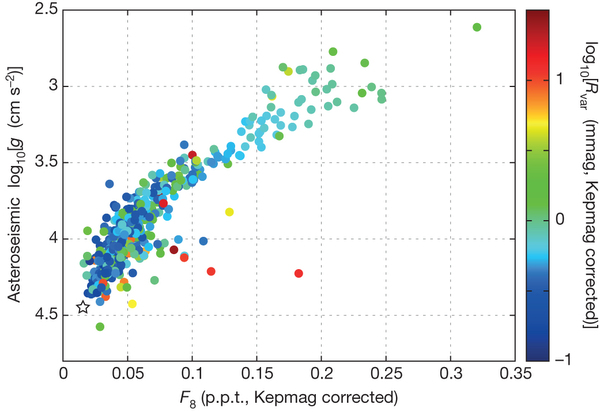
Twinkling stars:
A simple but powerful way to measure fundamental stellar properties, improve knowledge of exoplanet characteristics, and understand how stars evolve.
Variations in the brightness of solar-type stars are driven by many factors including granulation, a consequence of heat convection below the photosphere. And as granulation is correlated with surface gravity, variations in brightness can be used as a measure of surface gravity. Fisk-Vanderbilt Bridge student Fabienne Bastien and collaborators analyze archival data from NASA's Kepler mission and show that brightness fluctuations on timescales of less than 8 hours are correlated with the surface gravity in Sun-like stars in various evolutionary phases. Using straightforward measurements of this type it should be possible to determine the surface gravities of many of the stars observed by Kepler, and will permit much more accurate determination of the characteristics of planets orbiting these stars. The research is published in Nature, featured on the Vanderbilt News site, on the Nature Podcast, Nature Video, and in a related Nature News & Views article.

Cosmic conundrum:
The binary star system Par 1802 within the Orion Nebula poses a riddle in stellar evolution.
Two stars, each with the same mass and in orbit around each other, are twins that one would expect to be identical. So the discovery of twin stars in the Orion Nebula that are not identical at all comes as a surprise. In fact, these stars exhibit significant differences in brightness, temperature, and radius. The study, which is published in Nature, suggests that one of the stars formed significantly earlier than its twin. The discovery provides an important new challenge for today's star formation theories. Look here for a video interview from the National Science Foundation. The discovery is also featured in Nature's Making the paper column and the Nature podcast. The Vanderbilt Explorations website features a multimedia presentation of the results.

Magnificent Failures:
Discovery of a rare brown-dwarf eclipsing binary
Brown dwarfs are often called “failed stars” because their low
masses are intermediate to those of planets and stars. Until recently,
the fundamental physical properties of brown dwarfs were largely unkown.
The discovery of a pair of brown dwarfs in an eclipsing binary system
provides the first direct measurements of the masses, diameters, temperatures,
and luminosities of these failed stars. See the Vanderbilt
Explorations website for a multimedia feature about this research.
Also check out NPR's
Earth & Sky interview and radio
story.
The informatics revolution in astronomy and astrophysics
My research
seeks to address questions related to the formation of stars and planetary
systems. With the advent of all-sky surveys, large-format detectors, and high-performance computers, this work increasingly involves approaches at the interface of astronomy, physics, computer science, and informatics. This is the domain of the Vanderbilt Initiative in Data-Intensive Astrophysics (VIDA), through which we participate in the Sloan Digital Sky Survey and other large-scale collaborations.
Key questions of interest include:
- What are the physical processes involved in stellar birth, and which theory of star formation provides the most accurate description of a young star's evolution?
- What are the physical processes involved in planet formation, and how long does this process take?
- Under what conditions are planets destroyed?
- How do young stars produce energetic X-ray radiation, and what is the impact of this radiation on the environment of young Earth-like planets?
- By what mechanism(s) do young stars slow down the very rapid rotation that should result from their gravitational collapse?


Exoplanets
My research team is involved in the exciting hunt for planets around other stars, including planets most like our Earth as well as planets undergoing extreme conditions that help us understand how and when planets are destroyed. We principally carry out this work principally through our own Kildodegree Extremely Little Telescope (KELT) project--which has discovered more than 20 planets and other interesting phenomena so far, especially some of the most extreme--and the NASA TESS (Transiting Exoplanet Survey Satellite) mission, for which our group is responsible for the TESS Input Catalog and Candidate Target List.
Stellar
Mass
Mass is the most important property of a star, determining the course
of its birth, life, and death. My work in this area seeks to test and
inform theories of early stellar evolution, particularly via empirical
mass measurements of young stars. The number of pre-main-sequence stars
with empirically determined masses is increasing, but remains small. As
such, the pre-main-sequence stellar evolutionary models that are used
to infer stellar masses, ages, and other basic stellar properties, remain
largely uncalibrated by observation. This limits the ability of astronomers
to discriminate between different star-formation scenarios and to accurately
determine the timescales for planet formation.
Stellar
Angular Momentum
The so-called
"angular momentum conundrum" of how stars shed most of their
initial angular momentum continues to pose a fundamental astrophysical
challenge to our understanding of the star-for mation process.
My work in this area includes:
- modeling the rotational evolution of young, low-mass stars from the stellar birthline to the main sequence
- determining the distribution of stellar rotation rates among stars at various ages
- understanding the role of circumstellar disks in regulating angular momentum evolution
- ascertaining the influence of stellar multiplicity on early stellar angular momentum evolution
Stellar X-rays
Young stars produce
as much as 1000 times more X-ray radiation than the Sun. How do they
do this? My work in this area seeks to understand how this intense X-ray
radiation is produced and how these X-rays may affect the environment
in which planets form.
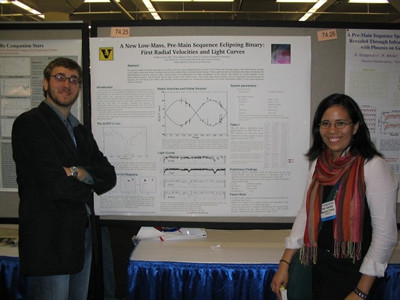
Students Phillip
Cargile (left) and Yilen Gómez Maqueo Chew (right)
presenting at a recent meeting of the American Astronomical Society.